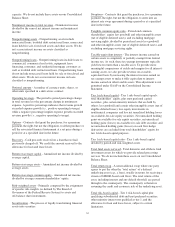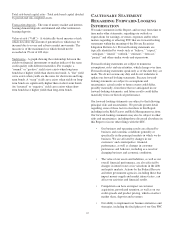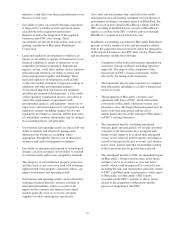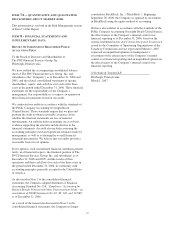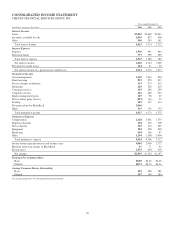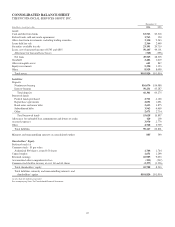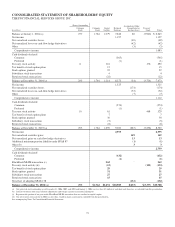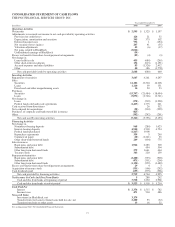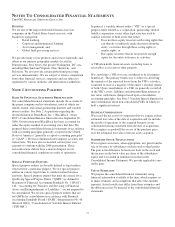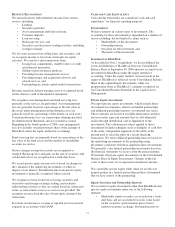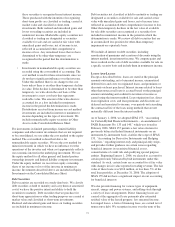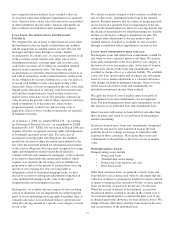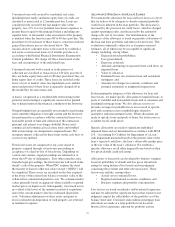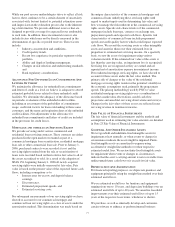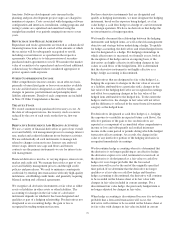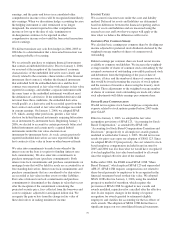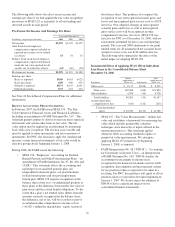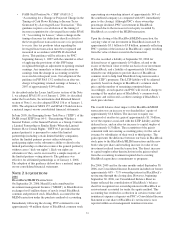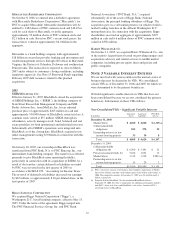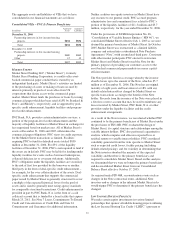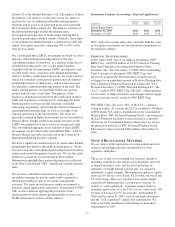PNC Bank 2006 Annual Report Download - page 84
Download and view the complete annual report
Please find page 84 of the 2006 PNC Bank annual report below. You can navigate through the pages in the report by either clicking on the pages listed below, or by using the keyword search tool below to find specific information within the annual report.these securities is recognized in net interest income.
Those purchased with the intention of recognizing
short-term profits are classified as trading, carried at
market value and classified as short-term
investments. Both realized and unrealized gains and
losses on trading securities are included in
noninterest income. Marketable equity securities not
classified as trading are designated as securities
available for sale and are carried at fair value with
unrealized gains and losses, net of income taxes,
reflected in accumulated other comprehensive
income or loss. Any unrealized losses that we have
determined to be other-than-temporary are
recognized in the period that the determination is
made.
• Investments in nonmarketable equity securities are
recorded using the cost method of accounting. The
cost method is used for those investments since we
do not have significant influence over the investee.
Under this method, there is no change to the cost
basis unless there is an other-than-temporary decline
in value. If the decline is determined to be other than
temporary, we write down the cost basis of the
investment to a new cost basis that represents
realizable value. The amount of the write-down is
accounted for as a loss included in noninterest
income in the period the determination is made.
Distributions received from income on cost method
investments are included in interest or noninterest
income depending on the type of investment. We
include nonmarketable equity securities in Other
Assets on the Consolidated Balance Sheet.
For investments in limited partnerships, limited liability
companies and other minor investments that are not required
to be consolidated, we use either the cost method or the equity
method. The cost method is described above for
nonmarketable equity securities. We use the cost method for
minor investments in which we have no influence over the
operations of the investee and when cost appropriately reflects
our economic interest in the underlying investment. We use
the equity method for all other general and limited partner
ownership interests and limited liability company investments.
Under the equity method, we record our equity ownership
share of net income or loss of the investee in noninterest
income. Investments described above are included in Equity
Investments on the Consolidated Balance Sheet.
Debt Securities
Debt securities are recorded on a trade-date basis. We classify
debt securities as held to maturity and carry them at amortized
cost if we have the positive intent and ability to hold the
securities to maturity. Debt securities that we purchase for
short-term appreciation or other trading purposes are carried at
market value and classified as short-term investments.
Realized and unrealized gains and losses on trading securities
are included in noninterest income.
Debt securities not classified as held to maturity or trading are
designated as securities available for sale and carried at fair
value with unrealized gains and losses, net of income taxes,
reflected in accumulated other comprehensive income or loss.
Other-than-temporary declines in the fair value of available
for sale debt securities are recognized as a securities loss
included in noninterest income in the period in which the
determination is made. We review all debt securities that are
in an unrealized loss position for other-than-temporary
impairment on a quarterly basis.
We include all interest on debt securities, including
amortization of premiums and accretion of discounts using the
interest method, in net interest income. We compute gains and
losses realized on the sale of debt securities available for sale on
a specific security basis and include them in noninterest income.
L
OANS
A
ND
L
EASES
Except as described below, loans are stated at the principal
amounts outstanding, net of unearned income, unamortized
deferred fees and costs on originated loans, and premiums or
discounts on loans purchased. Interest income related to loans
other than nonaccrual loans is accrued based on the principal
amount outstanding and credited to net interest income as
earned using the interest method. Loan origination fees, direct
loan origination costs, and loan premiums and discounts are
deferred and amortized to income, over periods not exceeding
the contractual life of the loan, using methods that are not
materially different from the interest method.
As of January 1, 2006, we adopted SFAS 155, “Accounting
for Certain Hybrid Financial Instruments – an amendment of
FASB Statements No. 133 and 140,” which was issued in
February 2006. SFAS 155 permits a fair value election for
previously bifurcated hybrid financial instruments on an
instrument-by-instrument basis, clarifies the scope of SFAS
133, “Accounting for Derivative Instruments and Hedging
Activities,” regarding interest-only and principal-only strips,
and provides further guidance on certain issues regarding
beneficial interests in securitized financial assets,
concentrations of credit risk and qualifying special purpose
entities. Beginning January 1, 2006, we elected to account for
certain previously bifurcated hybrid instruments under this
standard. As such, certain loans are accounted for at fair value
with changes in fair value reported in trading revenue. The fair
value of these loans was $216 million, or less than .5% of the
total loan portfolio, at December 31, 2006. The adoption of
SFAS 155 did not have a significant impact on our accounting
for beneficial interests.
We also provide financing for various types of equipment,
aircraft, energy and power systems, and rolling stock through
a variety of lease arrangements. Direct financing leases are
carried at the aggregate of lease payments plus estimated
residual value of the leased property, less unearned income.
Leveraged leases, a form of financing lease, are carried net of
nonrecourse debt. We recognize income over the term of the
74


